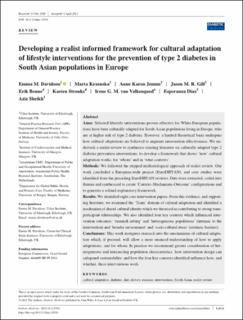Developing a realist informed framework for cultural adaptation of lifestyle interventions for the prevention of type 2 diabetes in South Asian populations in Europe
Davidson, Emma M.; Krasuska, Marta; Jenum, Anne Karen; Gill, Jason; Beune, Erik; Stronks, Karien; van Valkengoed, Irene G. M.; Perez, Esperanza Diaz; Sheikh, Aziz
Journal article, Peer reviewed
Published version

Åpne
Permanent lenke
https://hdl.handle.net/11250/2977052Utgivelsesdato
2021Metadata
Vis full innførselSamlinger
Sammendrag
Aims
Selected lifestyle interventions proven effective for White-European populations have been culturally adapted for South Asian populations living in Europe, who are at higher risk of type 2 diabetes. However, a limited theoretical basis underpins how cultural adaptations are believed to augment intervention effectiveness. We undertook a realist review to synthesise existing literature on culturally adapted type 2 diabetes prevention interventions, to develop a framework that shows ‘how’ cultural adaptation works, for ‘whom’ and in ‘what contexts’.
Methods
We followed the stepped methodological approach of realist review. Our work concluded a European-wide project (EuroDHYAN), and core studies were identified from the preceding EuroDHYAN reviews. Data were extracted, coded into themes and synthesised to create ‘Context–Mechanism–Outcome’ configurations and to generate a refined explanatory framework.
Results
We identified eight core intervention papers. From this evidence, and supporting literature, we examined the ‘Team’ domain of cultural adaptation and identified a mechanism of shared cultural identity which we theorised as contributing to strong team-participant relationships. We also identified four key contexts which influenced intervention outcomes: ‘research setting’ and ‘heterogeneous populations’ (intrinsic to the intervention) and ‘broader environment’ and ‘socio-cultural stress’ (extrinsic barriers).
Conclusions
This work instigates research into the mechanisms of cultural adaptation which, if pursued, will allow a more nuanced understanding of how to apply adaptations, and for whom. In practice we recommend greater consideration of heterogeneous and intersecting population characteristics; how intervention design can safeguard sustainability; and how the four key contexts identified influence how, and whether, these interventions work.
